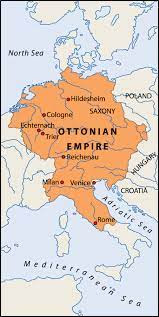Was his father-in-law. Charlemagne married Desiderius' eldest daughter, Desiderata, in 770. Marrying her was a political move, forging an alliance between the Lombards and the Franks. The marriage was annulled in 771, however, and she was sent back to her father.
The political alliances of Desiderius were all over the map, so to speak. When he was named King of the Lombards upon the death of his predecessor, King Aistulf, Aistulf's predecessor, his brother Rachis, who had been in a monastery, left it and tried to take the throne. Desiderius defeated him with the help of Pope Stephen II, after promising that he would give lands to the pope. The pope went for this, since Aistulf had made raids against papal lands. Desiderius, however, was not very forthcoming about handing control of the territories over to the papacy, so by the time Pope Stephen III came along, he was opposed to Charlemagne's marriage to Desiderata, and pushed for the annulment. It didn't really require what we think of as "annulment"; in the Middle Ages, "repudiation" was sufficient: the husband "repudiated" his wife and sent her back to her family. It was a holdover from Roman law. There were at least two dozen repudiated queens in the Middle Ages
Desiderius later tried, like Aistulf, to encroach on papal-controlled lands around Rome, and this time Pope Hadrian I called on Charlemagne's aid. It was expedient for Charlemagne to take up the request, since it allowed him to do a favor for the pope and annex Lombardy.
There was another "family connection" between Charlemagne and Desiderius. In 774, Charlemagne's brother Carloman died. Carloman's wife, Gerberga, might have expected her sons to inherit his territory, but Charlemagne simply absorbed it into his own. Gerberge fled with her sons to Pavia (and later, Verona) and took refuge with Desiderius. Desiderius, unhappy with the treatment of his daughter by Charlemagne, took in the refugees. This contributed to Charlemagne's willingness to besiege Pavia in aid of Pope Hadrian. The family was likely sent to monasteries, just like Desiderius, who was surely sorry that he ever got mixed up with the Frankish royal family.
What did Charlemagne do for a wife after Desiderata? He had three more. Let me tell you about them tomorrow.





















